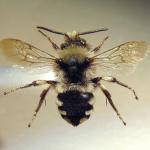Apis dubito HARRIS 1776; Apis interrupta GEOFFROY 1785; Apis leucopus GMELIN 1790; Apis albifrons ROSSI 1790; Apis bombinatrix variegata maior CHRIST 1791; Apis punctata PANZER 1804; Melecta lachesis NEWMAN 1835; Melecta atropos NEWMAN 1835; Melecta punctata LATREILLE 1802; Melecta fasciculata SPINOLA 1843; Melecta eversmanni RADOSZKOWSKI 1893; Melecta eczmiadzini RADOSZKOWSKI 1893
Formerly widely distributed in south-east England. It has not been found in Ireland or the Channel Islands. However, there has been no confirmed British record of this species for at least a century (New Forest, South Hants, 1912) and it seems very likely that the bee is now extinct in this country. Its demise was possibly a result of the rapid decline in Britain of its sole known host species (Anthophora retusa), though the last known record apparently pre-dated this event. Widely distributed in Eurasia, from Scandinavia to Spain, eastwards to Iran; possibly present in North Africa (Lieftinck 1980).
Listed as Endangered (RDB1) by Else & Spooner (in Shirt 1987) and by Falk (1991).
In the New Forest, South Hants, Nevinson (1902) found it flying along the banks of rides and remarked that it was curiously difficult to see. It would clearly have shared the same habitat of its host species.
Univoltine; late April to June or July.
A cleptoparasite of Anthophora retusa (e.g. Saunders 1896; Giordani Soika 1936; Lieftinck 1980). In Venice, Italy, Giordani Soika (1936) observed a female M. luctuosa breaking into a sealed cell of A. retusa. The egg of the cleptoparasite was laid on the provision, close to the young larva of the host species.
Hound's-tongue (Cynoglossum officinale) is the only British record (Nevinson 1902). In the Netherlands it visits cat-mint (Nepeta cataria), common gromwell (Lithospermum officinale) and white dead-nettle (Lamium album)(Lieftinck 1980).
None recorded.
Profile written:
Proofed: February 2012


